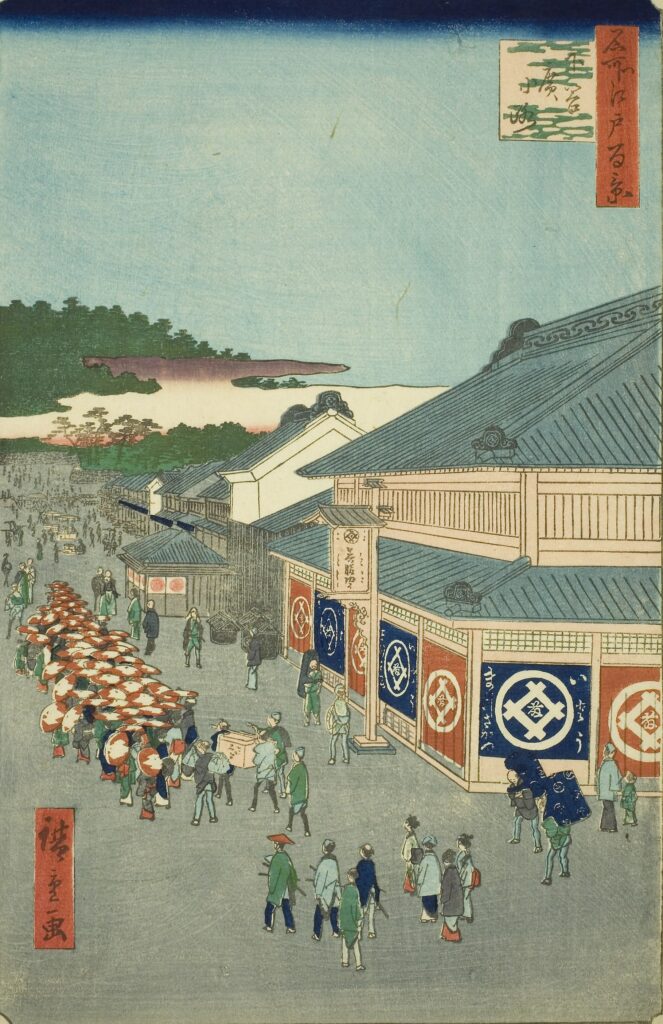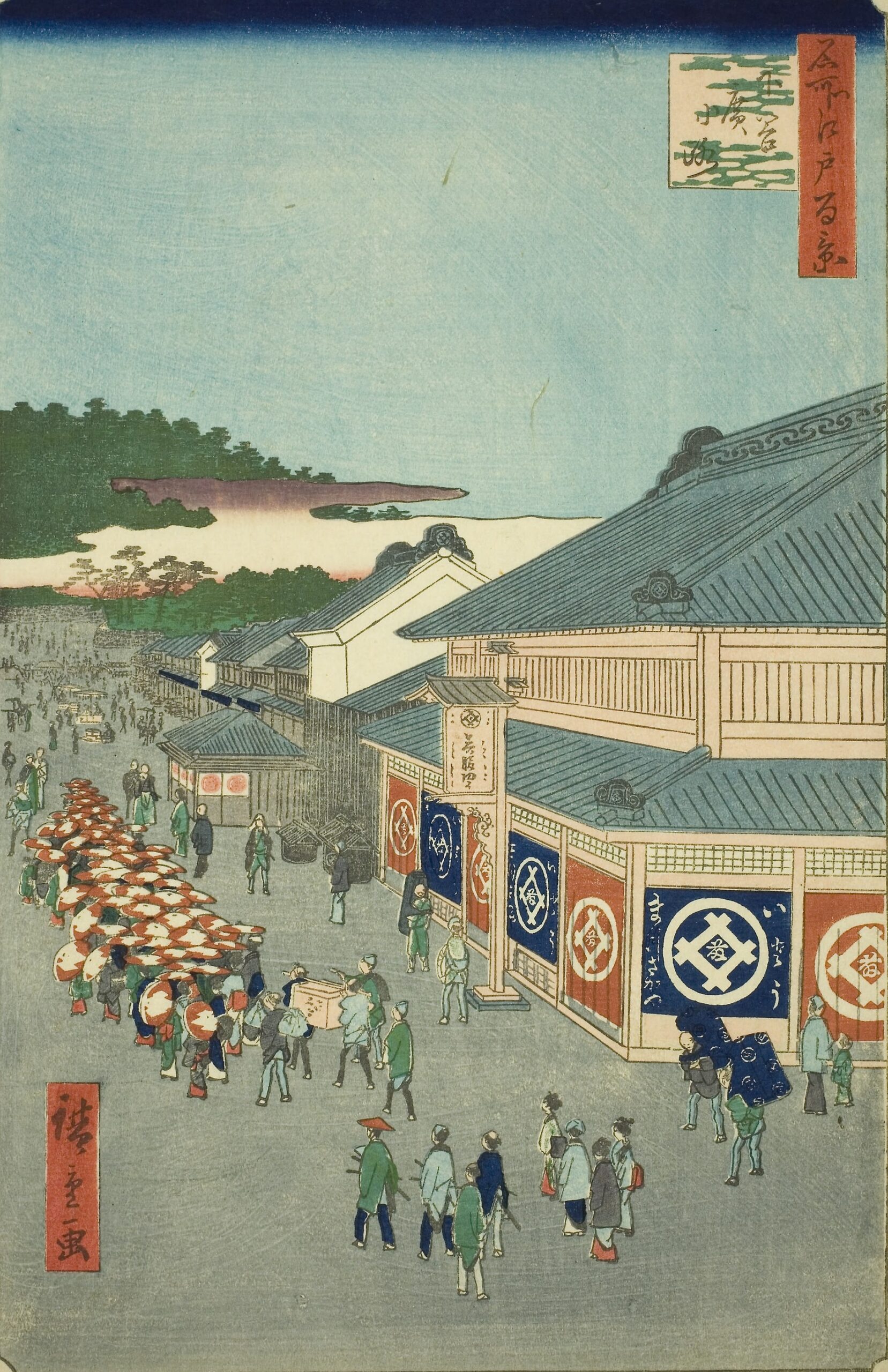
Utagawa Hiroshige – One Hundred Famous Views of Edo – 13 – Spring – Shitaya Hirokoji – Commentary 歌川広重-名所江戸百景-13-春-下谷廣小路 解説
Current Address: Matsuzakaya, 3-chome, Ueno, Taito-ku
Latitude and Longitude: Latitude 35.7102, Longitude 139.7745
Published: September 1856 Age: 60
Commentary
<1> Introduction
“Shitaya Hirokoji” is a work that vividly depicts Edo’s downtown culture and key transportation hub.
A place where bustling townspeople’s culture thrived, Hiroshige captured the vitality of Edo through the people passing by and the streetscape.
“Hirokoji” refers to a square derived from a firebreak (hiyokechi).
Edo suffered repeated destructive fires, so wide roads and open spaces were created to prevent the spread of fire.
These spaces were incorporated into people’s lives, and “Hirokoji” became the center of activity.
<2> What is Shitaya Hirokoji?
Shitaya is the area stretching from Ueno to Asakusa in present-day Taito Ward.
During the Edo period, it flourished as a temple town for Ueno Kan’ei-ji Temple, and many townspeople and artisans lived there.
Established as a firebreak, Hirokoji developed into a key transportation and commercial hub in Edo.
Lined with markets, theaters, and street stalls, it became a social gathering place for Edoites.
While Edo’s “Yamanote culture” was based on samurai residences and daimyo gardens, Shitaya’s Hirokoji is a symbol of townspeople culture.
The theaters, sideshow booths, and food stalls gathered here, providing entertainment for the common people.
<3> Highlights of the painting
Hiroshige meticulously depicts the people passing by on the street.
Shoppers, crowds heading to the theater, and merchants all convey a sense of vitality.
Hirokoji is lined with many temporary theaters and sideshow booths, and the painting depicts bustling signs and banners.
This scene gives a sense of the popular culture of the time.
The road stretches straight, with town houses lined on both sides.
The wide open space, making use of the firebreaks, illustrates the intersection of Edo’s urban planning and the lives of ordinary people.
The sight of people happily going back and forth is more than just a simple landscape; it reflects the unique charm of Edo, where the everyday lives of ordinary people and places of entertainment were integrated.
The main focus is on Hirokoji, leading to Kan’ei-ji Temple.
A large depiction of the kimono shop Matsuzakaya on Hirokoji is depicted.
This kimono shop was established in 1768 by Ito-ya, a kimono merchant founded in Nagoya, who purchased Matsuzakaya in Ueno.
The covered sign in front of the store reads “Kimono etc.”
The building slightly left of the center is a hairdresser.
<4> Hirokoji for the Common People of Edo
Hirokoji was a hub of entertainment, lined with theaters, variety halls, and sideshow booths.
Popular culture such as monkey shows, storytelling, and joruri puppet theater originated here.
Food stalls and food stalls lined the streets, where people could enjoy dumplings, sushi, and cheap sweets.
Edo’s “food-walking culture” was nurtured in places like Hirokoji.
Shitaya Hirokoji is located halfway between Ueno and Asakusa, and was a place where many people and goods passed through.
It was a convenient place for travelers and merchants to stop by.
<5> Walking Shitaya Hirokoji Today
The place name “Hirokoji” remains in the Ueno and Okachimachi areas of Taito Ward today, conveying memories of that time.
The name “Ueno Hirokoji Station” also reflects this history.
Modern-day Ueno and Okachimachi are lined with department stores and restaurants, maintaining their role as “districts of commerce and entertainment” that dates back to the Edo period.
Combined with easy access to Ueno Park, Shinobazu Pond, and Asakusa, the area’s character as a “bustling gathering place” as depicted by Hiroshige remains strong today.
<6> Sightseeing Guide
1. Stroll Around Ueno-Hirokoji Station
Imagine the bustling atmosphere of Edo while walking through this modern-day downtown area.
2. Okachimachi Shopping Street
A shopping district that carries on the traditions of an artisan district from the Edo period.
3. Ueno Park
Just off Hirokoji, this cultural district is dotted with Kan’ei-ji Temple, museums, and art galleries.
4. The Road to Asakusa
Just like in the Edo period, the route via Hirokoji to Sensoji Temple is an ideal sightseeing spot.

